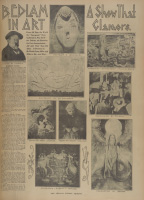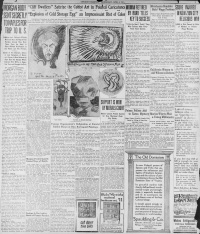Chicago's reaction to the Armory Show has often been reduced by historians to the infamous characterization of the city as a "rube town" proffered by Walt Kuhn, the executive secretary of the Association of American Painters and Sculptors (AAPS). This account suggests that critical response to the exhibition was limited to sensationalism, uninformed ridicule, and moral denunciation. While such commentary certainly comprised a large part of the press copy, public opinion was much more varied and nuanced. From the beginning, Chicago audiences were well informed about the show based on coverage of the New York presentation. By mid-March, however, when the city's newspapers began to publish regular commentary on the upcoming exhibition, the initial, positive accounts in the New York press had been supplanted by increasingly unflattering characterizations of the foreign section of the exhibition as the work of degenerates and charlatans. Taking their cue from such articles, the Chicago press buzzed with jocular skepticism and curiosity.
Chicago's reaction to the Armory Show has often been reduced by historians to the infamous characterization of the city as a "rube town" proffered by Walt Kuhn, the executive secretary of the Association of American Painters and Sculptors (AAPS).1This account suggests that critical response to the exhibition was limited to sensationalism, uninformed ridicule, and moral denunciation. While such commentary certainly comprised a large part of the press copy, public opinion was much more varied and nuanced. From the beginning, Chicago audiences were well informed about the show based on coverage of the New York presentation. By mid-March, however, when the city's newspapers began to publish regular commentary on the upcoming exhibition, the initial, positive accounts in the New York press had been supplanted by increasingly unflattering characterizations of the foreign section of the exhibition as the work of degenerates and charlatans. Taking their cue from such articles, the Chicago press buzzed with jocular skepticism and curiosity. Hoping to whip up excitement and sell admission tickets, Newton H. Carpenter, executive secretary of the Art Institute, seems to have fueled the fire; as Director William M. R. French wrote, "Mr. Carpenter is having a beautiful time, working it up as a kind of circus and sensation."2 This mood seeped into the galleries as well. Shortly after the exhibition opened, French's assistant, Charles H. Burkholder, wrote: "In Room 50 yesterday, I heard a man laugh at the top of his voice. He inflamed the entire company, and everybody roared. Even Pach, who was with me, became convulsed."3 Indeed, Walter Pach, who as the AAPS's sales agent was present in the galleries daily, took a much more cheerful view of the show's reception than did Kuhn. Writing to his friend, the collector Michael Stein, who lived in Paris, Pach reported, "You would be astounded at the amount of intelligence I find in my rounds of the galleries . . . even as a small fraction of the comment, it more than makes up for the idiots."4
1 According to Milton W. Browne, The Story of the Armory Show (New York: Abbeville Press, 1988), p. 170.
2 French to Hallowell, Mar. 18, 1913. French—Letter Books, box 16, vol. 2, 1912–13, AIC Archives.
3 Burkholder to French, Mar. 27, 1913. French—Letter Books, box 16, vol. 2, 1912–13, AIC Archives.
4 Pach to Michael Stein, Mar. 30, 1913. Gertrude Stein manuscript collection, quoted in Laurette E. McCarthy, "The "Truths" about the Armory Show: Walter Pach's Side of the Story," Archives of American Art Journal, 44, 3–4 (Fall 2004), p. 7.

Harriet Monroe, A Critical Voice As a Chicago Daily Tribune art critic, Harriet Monroe gave the Armory Show serious consideration; despite some initial skepticism about the more radical works in the exhibition, her writings demonstrate not only her efforts to responsibly inform the public about the new art but to understand and appreciate the works herself.





